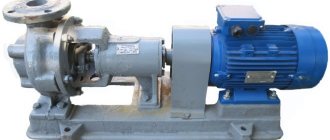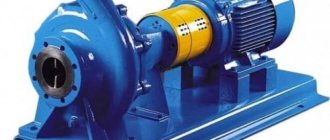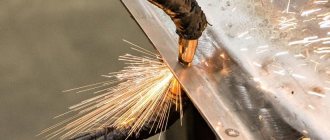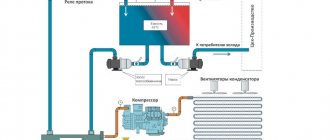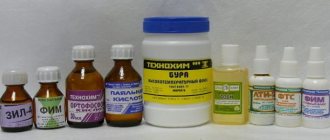When looking for a reliable, durable and environmentally friendly material for home plumbing, many people choose copper pipes. However, only the thermal method - soldering - can ensure high-quality, hermetic and durable joining of the parts of such a pipeline. Let's look at what the features of this technology are, how to correctly use a special torch for soldering, what types of it exist, how to choose it correctly for specific conditions, and what are the main stages of the joining procedure.
Manual gas torch for soldering copper tubes at home Source siteapi.org
Soldering copper pipes - features, necessary equipment
The essence of soldering sections of copper pipeline comes down to preliminary preparation of the edges of the pipes being connected, filling the gap between them with a special alloy solder, subsequent heating and cleaning the surface. Moreover, unlike welding, when the material of the structures being connected melts and thereby forms a single structure, joining occurs due to a different composition. Its melting point is always lower than that of the pipe material.
The soldering procedure, depending on the temperature used, is classified into 2 main types:
- 600-900 °C. To heat the alloy, professional burners are used that produce a high-temperature flame. They operate on propane, butane, acetylene and oxygen. The method is suitable for installation of pipelines operating under heavy loads.
- No more than 500 °C. The method is used for soldering using soft and hard solder at home. To achieve the required heating level, use conventional gas burners or electric soldering irons.
Soldering a copper pipeline with hard solder Source plavitmetall.ru
Traditionally, gas burners are used for soldering copper pipes, which, regardless of their purpose and design, usually consist of the following main working units:
- Instrument head.
- Gearbox.
- Injectors.
- Gas supply regulator.
- Cylinder mounts.
The substance that binds the edges of pipes together during heat treatment is called solder. There are two main types of it:
- Soft. It has the shape of a wire, with a cross-section from 2 to 6 mm.
- Solid. They are rods that are distinguished not only by a higher melting point, but also by better performance characteristics - they allow the pipeline to withstand greater pressure.
Solder can contain various types of metals - tin, zinc, copper, lead, silver, and phosphorus. Also, to ensure high-quality uniform soldering, flux must be used. These can be either individual substances in the form of resins, rosin, wax, or ready-made mixtures based on zinc chloride, boric and hydrochloric acid.
Before starting the tube soldering procedure, you must properly prepare Source ytimg.com
In addition to the main tool - a gas burner - for pipeline installation, additional devices will be required to prepare the edges of the pipes for joining - chamfering, expanding, stripping, cutting, etc.
Advice! The most common material for soldering is PIC - tin-lead solder. Its melting point is only 180 °C. However, if you want to create the strongest possible joint, it is better to use compounds based on copper, phosphorus and silver. The seam formed with its help has the same expansion coefficient as a copper pipe and can withstand heating up to 200 °C.
See also: Catalog of companies that specialize in engineering systems (heating, water supply, sewerage and others) and related work
Assembling a pipeline using fittings
Copper pipes are connected using fittings only in places accessible for inspection. This rule is due to the fact that the connection is not completely sealed and leaks may form over time.
The advantage of a threaded connection is that, if necessary, repairs can be made without additional effort, since the resulting connection is detachable.
Tools and materials
To assemble the pipeline, you will need the following materials and tools:
- copper pipes of suitable diameter;
- connecting crimp or press fittings;
Special devices for pipeline assembly
The types and number of fittings are selected in accordance with the pipeline diagram.
- pipe cutter or hacksaw for metal;
- pipe bender for copper pipes. The device is used to organize a pipeline with fewer connections, which increases the strength of the system;
- file for processing pipes after cutting (before joining). Additionally, you can use fine sandpaper;
- FUM tape for sealing threads. In addition to FUM tape, you can also use linen thread, Tangit Unilok thread or any other sealing material;
- wrench.
Assembly instructions
Assembling a copper pipeline with your own hands using fittings is done in the following way:
- cutting pipes for pipelines. The length of each pipe must fully comply with the diagram drawn up during the development of the system;
- removal of the insulating layer. If pipes with insulation are used for a pipeline system being installed for any purpose, then the insulating layer is removed for a durable connection. To do this, cut the desired area with a knife and clean the pipe;
- The cut edge is processed with a file and sandpaper until a smooth surface is obtained. If burrs, potholes or other irregularities remain at the end of the pipe, the connection will be less tight;
Cleaning the pipe before connecting to the fitting
- if necessary, pipes are bent;
- a union nut and a ferrule are put on the prepared pipe;
Installation of fitting elements for connection
- the pipe is connected to the fitting. Initially, tightening is done by hand and then with a wrench. During the tightening process, the crimp ring completely seals the connection, eliminating the need to use additional sealants. However, when connecting a copper pipe to a pipe or fitting made of a different material, additional sealing with FUM tape is required.
Fixing the fitting
It is important not to overtighten the threads, as soft copper is easily deformed.
Varieties
Depending on the characteristics of the pipeline being constructed, copper soldering with a gas torch can be carried out under different conditions. Therefore, devices with different performance characteristics can be used for heating. First of all, this equipment is classified according to flame temperature and scope of application into 2 main categories:
- Household. The flame temperature does not exceed 1000-1500 °C. They are characterized by low cost, but also limited functionality.
Soldering a copper pipeline with a household gas torch Source stroy-podskazka.ru
- Professional. The flame heats up to 2000 °C. More expensive models designed for large volumes of work.
Based on the composition of the gas fuel used, devices are divided into 3 types:
- Propane. The flame is powered by propane gas. The most common models. They are distinguished by their versatility, flame intensity, piezo ignition, and economical fuel consumption.
- MAPP gas. The burner flame has a high temperature, but has a more restrained effect on the pipe material, which effectively affects the quality of the soldering.
- Acetylene-oxygen. Produces a high temperature flame. They are used in industrial quantities - for the installation of highways. If handled incorrectly, the material may burn through.
In addition, burners differ in modification of the fuel source into 2 categories:
- With disposable cylinders.
Gas for soldering copper pipes comes from a removable, disposable cylinder. The fuel is propane, as well as acetylene and other gas mixtures. The supply is adjusted by tightening the valve on the handle.
For a small amount of work, it is more convenient to use a hand torch with a disposable cylinder Source specinstrumenta.ru
Selection rules
When choosing a torch for soldering copper and copper pipes with hard or soft solder, the following series of criteria must be taken into account:
- Power. It is influenced by temperature, flame intensity, and the ability to adjust the burning rate. The parameter is set by the wall thickness, pipe diameter and volume of work.
- The type of gas fuel used and its availability under specific conditions of use. The possibility of changing the type of gas used should also be taken into account - for example, switching from acetylene to propane and vice versa.
- Purpose. The torch can be used not only for soldering, but also for cutting and melting metal, which significantly expands its versatility.
- Type of material being processed. In practice, it is often necessary to connect not only copper, but also bronze, brass and steel pipes and fittings.
Important! The soldering procedure involves high-temperature treatment. The likelihood of getting a burn is maximum. Therefore, before starting work, it is necessary to make sure that all necessary technical requirements and safety regulations will be followed impeccably.
When soldering, you must follow safety precautions Source ytimg.com
Steps for soldering copper pipes
There are several basic rules for soldering copper tubes with a gas torch:
- Before starting the procedure, it is necessary to clean the surface of the edges to be joined from dust, dirt, paint, etc., without using products that create minor defects.
- Before applying solder, surfaces are treated with flux to prevent the formation of pores in the seam, adhesion and better melting of the alloy.
- Heating of all mating elements must be carried out evenly in order to avoid under- or overheating, thereby deteriorating the quality of the joint.
- A gap of about 25-125 microns should be left between the surfaces of the inner and outer walls of the joined edges.
- Upon completion of soldering, in order to avoid the development of corrosion processes, flux must be removed from the surface.
Flux
Most types of solders require pre-treatment of the pipes with a special compound called flux.
Flux is produced:
in liquid form;
Liquid soldering compounds
in the form of a paste.
Soldering compound in paste form
It is preferable and more convenient to use flux made in the form of a paste, since a harder composition facilitates uniform application and does not spread over the surface of the pipe.
Flux allows:
- carry out additional cleaning of pipes from oxides;
- distribute the solder more evenly during the soldering process;
- protect the joint from corrosion and oxide formation.
Video description
Video instructions for soldering copper pipes with a gas torch:
Soldering with soft solder is carried out according to the following algorithm:
- The edges of the pipe sections are prepared and joined.
- Flux is applied to the contact area.
- Using a burner, the ends of the tubes are heated.
- As soon as the flux changes color, the edge of the solder wire is inserted into the joint.
- As the alloy melts, the structure is rotated around its axis as much as possible to fill it more evenly.
- Upon completion of the procedure, the metal is allowed to cool, after which the remaining flux is removed from its surface.
Brazing copper tubes with a gas torch is carried out in a similar way. The only excellent point in the technology is the need to preheat the refractory solder alloy so that it can acquire the desired state of ductility.
On a note! One of the most common mistakes during soldering is the wrong choice of solder. If possible, the alloy should have similar physical and chemical properties as the structure being connected. First of all, this concerns the coefficient of thermal expansion of metals. If there is a large difference, the seam will begin to deform over time and begin to leak.
Briefly about the main thing
Using a gas torch to connect copper pipes allows you to create a strong permanent joint. In everyday life, the procedure is performed at a low flame temperature - no more than 500 °C, on an industrial scale - about 900 °C. The substance that acts as a connector between the edges of the pipes is a special solder alloy. It contains tin, lead, zinc, copper and other elements. It can be soft and hard. In addition to this, flux is also required. Its task is to increase adhesion and create a uniform seam.
Gas burners for soldering copper pipes are classified according to several criteria:
- Flame temperature and area of use - domestic and professional.
- The composition of gas fuels is propane, acetylene-oxygen and MAPP gas.
- Type of gas source - with disposable cylinders and stationary.
When choosing a burner, it is necessary to take into account the power, type of gas fuel, the set of operations performed and the type of material for which they are intended to process. The soldering procedure can be performed on both soft and hard solder, but with strict adherence to special rules and technology.
How to choose a burner
When choosing equipment, the main attention should be paid to the class and performance characteristics.
If you buy a torch only for soldering household pipelines, you can get by with a manual or semi-professional device. Such a device is cheaper than a professional burner and will cope with the tasks. To install communications subject to high loads, you will need to use hard solders, so you will have to purchase professional equipment.



